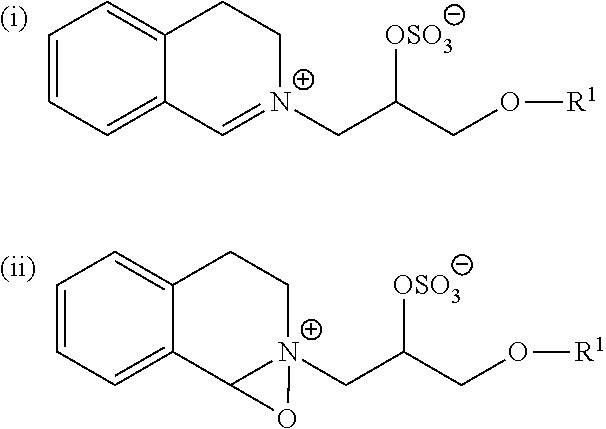Cleaning compositions comprising enzymes
a technology of enzymes and compositions, applied in detergent compositions, detergent compounding agents, enzymology, etc., can solve the problems of sticky items and difficult removal
- Summary
- Abstract
- Description
- Claims
- Application Information
AI Technical Summary
Benefits of technology
Problems solved by technology
Method used
Image
Examples
example 1
Extraction of EPS (Extracellular Polymeric Substances) from Pseudomonas fluorescens
[0312]A Pseudomonas fluorescens isolate from Iceland was used as a model microorganism in the present example. Pseudomonas fluorescens was restreaked on Tryptone Soya Agar (TSA) (pH 7.3) (CM0131; Oxoid Ltd, Basingstoke, UK) and incubated for 1 day at 23° C. The strain was inoculated into 10 mL of TSB and the culture was incubated with shaking for 16 hours at 23° C. The overnight culture was diluted (1:100) in 200 ml M63 supplemented medium (15 mM (NH4)2SO4, 100 mM KH2PO4, 1.8 μM FeSO4, 1 mM MgSO4.7H2O, 0.4% (w / v) glycerol, 0.2% (w / v) Casamino acids and 0.0001% (w / v) Thiamine) added to a Corning® CelIBIND® 225 cm2 Angled Neck Cell Culture Flask with Vent Cap and incubated statically for 5 days at 23° C. The biofilm culture was subsequently transferred to four 50 ml Falcon tubes and pelleted by centrifugation (10 min, 8000 g, 25° C.), and the supernatants were discarded completely. The residual pellets...
example 2
Synergistic Effect Between Hexosaminidase and DNase on Deep-Cleaning in Liquid Model Detergent
[0315]50 ul aliquots of the crude EPS described in Example 1 were spotted on sterile textile swatches (WFK20A) and incubated for 30 min at ambient temperature. The swatches (sterile or with EPS) were placed in 50 mL test tubes and 10 mL of wash liquor (150 dH water with 0.2 g / L iron(III) oxide nanopowder (544884; Sigma-Aldrich) with 3.33 g / L liquid model A detergent) and 0.2 ug / ml enzyme(s) was added to each tube. Washes without enzyme were included as controls. The test tubes were placed in a Stuart rotator and incubated for 1 hour at 37° C. at 20 rpm. The wash liquor was then removed, and the swatches were rinsed twice with 150 dH water and dried on filter paper over night. The remission (REM460 nm) values were measured using a Macbeth Color-Eye 7000 (CE7000), and are displayed in table 3. Delta values (REM460 nm (swatch washed with enzyme)−REM460 nm (swatch washed without enzyme)) are al...
example 3
Synergistic Effect Between Hexosaminidase and DNase on Deep-Cleaning in Liquid Model Detergent
[0317]A Pseudomonas fluorescens isolate from Iceland was used as a model microorganism in the present example. Pseudomonas fluorescens was restreaked on Tryptone Soya Agar (TSA) (pH 7.3) (CM0131; Oxoid Ltd, Basingstoke, UK) and incubated for 1 day at 23° C. A single colony was inoculated into 10 mL of TSB and the culture was incubated for 16 hours at 23° C. with shaking (Tetramax 1000 at 460 rpm). After propagation, the culture was diluted to an OD600 of 0.03 in fresh TSB and 1.65 mL aliquots were added to the wells of 12-well polystyrene flat-bottom microplates (3512; Costar, Corning Incorporated, Corning, N.Y., USA), in which round swatches (diameter 2 cm) of sterile textile (WFK20A) had been placed. Sterile TSB was added to control wells. After 48 h at 23° C. (static incubation), the swatches were rinsed twice with 0.9% (w / v) NaCl.
[0318]Five rinsed swatches (sterile or with P. fluouresce...
PUM
| Property | Measurement | Unit |
|---|---|---|
| temperature | aaaaa | aaaaa |
| concentration | aaaaa | aaaaa |
| concentration | aaaaa | aaaaa |
Abstract
Description
Claims
Application Information
 Login to View More
Login to View More - R&D
- Intellectual Property
- Life Sciences
- Materials
- Tech Scout
- Unparalleled Data Quality
- Higher Quality Content
- 60% Fewer Hallucinations
Browse by: Latest US Patents, China's latest patents, Technical Efficacy Thesaurus, Application Domain, Technology Topic, Popular Technical Reports.
© 2025 PatSnap. All rights reserved.Legal|Privacy policy|Modern Slavery Act Transparency Statement|Sitemap|About US| Contact US: help@patsnap.com

